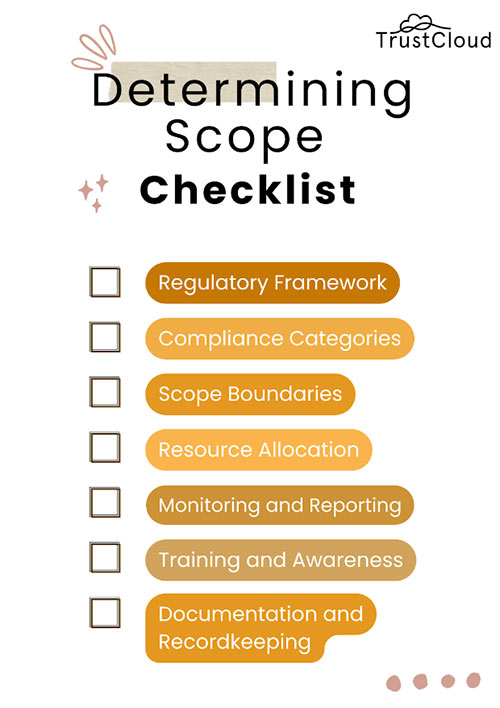How do I determine the scope of an audit?
The scope of a compliance audit is a well-defined and critical aspect of the audit planning process. This type of audit primarily focuses on assessing an organization’s adherence to relevant laws, regulations, policies, and industry standards. The scope outlines the specific areas and activities within the organization that will be examined to determine compliance levels. This may encompass a wide range of topics, including financial reporting, data protection, environmental regulations, labour laws, safety protocols, and ethical standards.
The audit scope serves as a roadmap for auditors, clearly defining the boundaries and objectives of the audit, and ensuring that it remains comprehensive and targeted. It also guides the allocation of resources, helps in risk assessment, and allows for effective communication of audit objectives to stakeholders. A well-structured compliance audit scope is essential for delivering a thorough and unbiased assessment of an organization’s compliance status.
Furthermore, the scope of the compliance audit will extend to a review of the organization’s security incident response and breach detection capabilities to ensure readiness in case of a data breach. The audit period will cover the most recent fiscal year, starting from January 1, 20XX, to December 31, 20XX, and will include an examination of all relevant documentation, security controls, and interviews with key personnel.
It’s important to note that this compliance audit scope does not encompass other regulatory frameworks or non-payment card-related compliance matters. The primary goal is to assess and verify the organization’s compliance with PCI DSS requirements to ensure the security of payment card data and protect against potential data breaches.
How to scope an audit
Scoping an audit is a critical step in the audit planning process. It involves defining the objectives, boundaries, and key parameters of the audit to ensure that it is conducted effectively and efficiently. Here’s a step-by-step guide on how to scope an audit:
- Audit Purpose and Objectives: Start by understanding why the audit is being conducted. What are the goals and objectives of the audit? What is the primary reason or concern that prompted the audit? This will help you establish the purpose and focus of the audit. Clearly articulate the specific goals and objectives of the audit. These objectives should be measurable and directly related to the audit’s purpose. For example, if you’re auditing financial statements, your objectives might include verifying the accuracy of financial data or assessing compliance with accounting standards.
- Audit Scope: Determine the specific area, process, or system that will be the focus of the audit. This could be financial statements, internal controls, compliance with regulations, operational processes, or any other aspect of the organization. Determine the boundaries of the audit. What will be included in the audit, and what will be excluded? Consider factors such as time, geography, departments, or specific elements within the subject area. Be explicit about what is within the scope and what is not. Create a formal document that clearly outlines the audit scope, objectives, boundaries, stakeholders, resources, and constraints. This document should serve as a reference throughout the audit process.
- Key Stakeholders: Identify the key stakeholders who have an interest in the audit. This could include senior management, board members, regulatory bodies, or other relevant parties. Understanding their expectations and concerns can help shape the audit scope.
- Resources and Constraints: Evaluate the resources available for the audit, including budget, staff, and time. Also, consider any constraints, such as legal or regulatory limitations, that may impact the scope or timeline of the audit.
- Risk Assessment: Conduct a risk assessment to identify potential risks and issues within the audit scope. This will help prioritize areas that require more attention during the audit process.
- Audit team and Management: Collaborate with the audit team and management to gather input and feedback on the proposed audit scope. Ensure that all relevant parties are in agreement with the scope and objectives.
- Reviews: Review the audit scope document with key stakeholders, obtain their approval, and make any necessary adjustments based on their feedback. Once the scope is finalized, it becomes the basis for the audit plan.
- Communicating the Scope: Communicate the audit scope to all relevant parties, including the audit team, management, and other stakeholders. Ensure that everyone involved in the audit understands what is expected and what will be covered.
- Scope Changes: Throughout the audit, continuously monitor the scope to ensure that it remains on track. If there are any changes or deviations from the original scope, document them and assess their impact on the audit’s objectives and timeline. Seek approval for scope changes when necessary.
Scoping an audit effectively is crucial for ensuring that the audit achieves its intended goals and provides valuable insights to stakeholders. It also helps in managing resources efficiently and maintaining audit quality.
Common challenges in determining the scope of an audit
Determining the scope of an audit is not without its challenges. One of the most common challenges is balancing the need for a comprehensive audit with the limitations of time and resources. There is often pressure to cover a broad range of areas within a tight timeframe, which can lead to a superficial audit that fails to delve deeply into any one area.
Another challenge is dealing with changing circumstances that may affect the audit scope. This could include new risks that emerge during the audit or changes in the organization’s operations or environment. Adapting the audit scope to these changes while maintaining its focus and objectives can be difficult.
Engaging with stakeholders to agree on the audit scope can also be challenging. Different stakeholders may have different priorities or concerns, leading to conflicting views on what the audit should focus on. Achieving consensus on the audit scope requires effective communication and negotiation skills.
Best practices for defining the audit scope
To overcome these challenges, there are several best practices that can be followed in defining the audit scope. One key practice is to start with a thorough understanding of the audit’s objectives and the organization’s operations. This provides a solid foundation for making informed decisions about the audit scope.
Another best practice is to use a risk-based approach to prioritize the areas to be included in the audit scope. This ensures that the audit focuses on the areas of greatest significance and potential impact.
Engaging with stakeholders throughout the process of defining the audit scope is also crucial. This ensures that the scope is aligned with the organization’s needs and that there is buy-in from all parties involved.
Regularly reviewing and adjusting the audit scope as necessary is another best practice. This allows the audit to remain relevant and focused in the face of changing circumstances or new information.
7-point scope checklist
Here is a quick checklist for you to make sure you have considered all major factors while determining your audit scope!

This 7-point checklist provides a more comprehensive overview of the key elements to consider when defining the scope of a compliance program, helping organizations establish a clear and well-structured compliance framework.
Want to learn more about GRC?
Explore our GRC launchpad to gain expertise on numerous compliance standards and topics.
Join our TrustCommunity to learn about security, privacy, governance, risk and compliance, collaborate with your peers, and share and review the trust posture of companies that value trust and transparency!
Learn more about how TrustCloud can help you ensure compliance and enhance your trust and business value.



